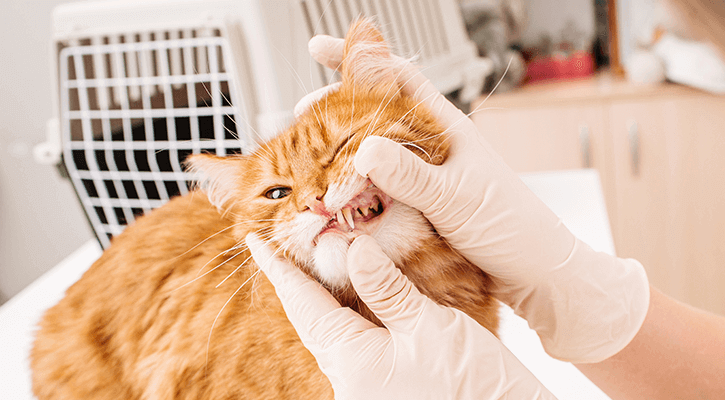
Dental Care
Your pet needs dental care – regular, professional care from your veterinarian, as well as care at home from you. An astounding 80 percent of dogs and 70 percent of cats show signs of oral disease by age 3, according to the American Veterinary Dental Society (AVDS).
As always, proper care and prevention are the best tools to fight gum disease and dental issues. A convenient and effective way to combat oral disease is by feeding specially formulated foods proven effective in combating plaque and tartar buildup. The Seal of Acceptance from the Veterinary Oral Health Council appears on products that meet defined standards for plaque and tartar control in dogs and cats.
What if your pet has gum disease? If your pet will allow it, open its mouth and look inside. Look for the warning signs of gum disease – bad breath, red and swollen gums, a yellow-brown crust of tartar around the gum line, and pain or bleeding when you touch the gums or mouth. If you suspect an issue, bring your pet in for a dental exam. Don’t wait for his annual checkup if there’s a problem.
At Springfield Veterinary Center we provide dental cleanings, evaluations, and extractions as well as preventative maintenance. Full anesthetic precautions and protocols are followed (see surgical anesthetic procedures). Thorough periodontal evaluations are performed at every prophylactic dental cleaning and polishing.
Tooth Brushing
Equally important to our annual oral health assessment for your pet is home dental care, including brushing your pet’s teeth every day. Yes, every day! It’s never too late to introduce a dog to the idea of dental care, but it is easier to start when your pet is younger. No matter when you decide to start it is best to begin slowly and gradually. Try to use a finger to gently rub along your dog’s gums and teeth. The most important area to focus on is the gum line (the crevice where the gums meet the teeth), where bacteria and food mix to form plaque. Focus on the gum line, start at the front to the mouth, then move to the back upper and lower teeth, and gum areas. Once your dog is used to this, gradually introduce gauze over your finger and rub the teeth and gums in a circular fashion.
When your pet can handle the gauze, try brushing with a toothbrush that is soft-bristled and specially designed for dogs or a soft, ultra-sensitive toothbrush designed for people (adults or children). A battery-powered toothbrush for dogs performs well and in most cases is well tolerated. The bristles should be held at a 45-degree angle to the tooth surface and be moved in an oval motion. Scrub along the gum line as this is where the odor and infection begin but be sure not to brush too hard. You can add in dog toothpaste if you like but remember to never use people’s toothpaste as it can upset your pet’s stomach. Toothpaste is a flavoring to enhance acceptance of the toothbrush but the most important aspect is manual tooth brushing.
We have a video on our website that further demonstrates this technique. Go to springfieldvetcenter.com and select tooth brushing under videos.
In addition to at-home brushing, there are tartar preventative diets, appropriate chew treats, and oral rinses and gels that can further help to reduce dental disease in your pet’s mouth. We would be happy to give you some safe and proven effective options, just ask one of our staff members! We share a common goal of keeping your pet happy and healthy.
Dental Care For Pets In Glen Allen, VA
Taking care of your precious dog or cat’s dental care starts with thorough dental cleanings and at-home cleanings. Give Springfield Veterinary Center a call at 804-270-7274 or fill out our request an appointment form today to schedule your pet dental care appointment!
